AMD Ryzen 5 3600 Review: Why Is This Amazon's Best Selling CPU?
by Dr. Ian Cutress on May 18, 2020 9:00 AM ESTCPU Performance: Synthetic, Web and Legacy Tests
While more the focus of low-end and small form factor systems, web-based benchmarks are notoriously difficult to standardize. Modern web browsers are frequently updated, with no recourse to disable those updates, and as such there is difficulty in keeping a common platform. The fast paced nature of browser development means that version numbers (and performance) can change from week to week. Despite this, web tests are often a good measure of user experience: a lot of what most office work is today revolves around web applications, particularly email and office apps, but also interfaces and development environments. Our web tests include some of the industry standard tests, as well as a few popular but older tests.
We have also included our legacy benchmarks in this section, representing a stack of older code for popular benchmarks.
All of our benchmark results can also be found in our benchmark engine, Bench.
GeekBench4: Synthetics
A common tool for cross-platform testing between mobile, PC, and Mac, GeekBench 4 is an ultimate exercise in synthetic testing across a range of algorithms looking for peak throughput. Tests include encryption, compression, fast Fourier transform, memory operations, n-body physics, matrix operations, histogram manipulation, and HTML parsing.
I’m including this test due to popular demand, although the results do come across as overly synthetic, and a lot of users often put a lot of weight behind the test due to the fact that it is compiled across different platforms (although with different compilers).
We record the main subtest scores (Crypto, Integer, Floating Point, Memory) in our benchmark database, but for the review we post the overall single and multi-threaded results.
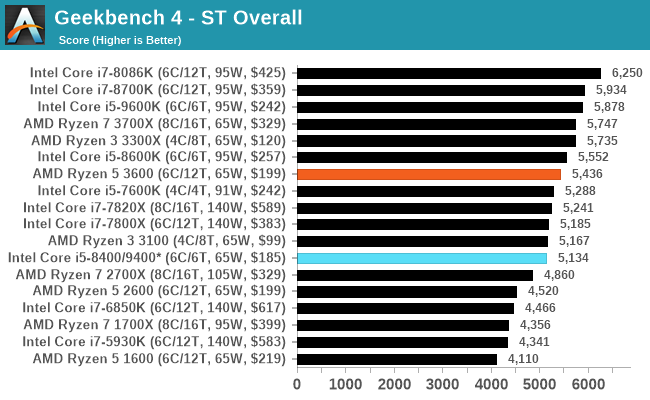
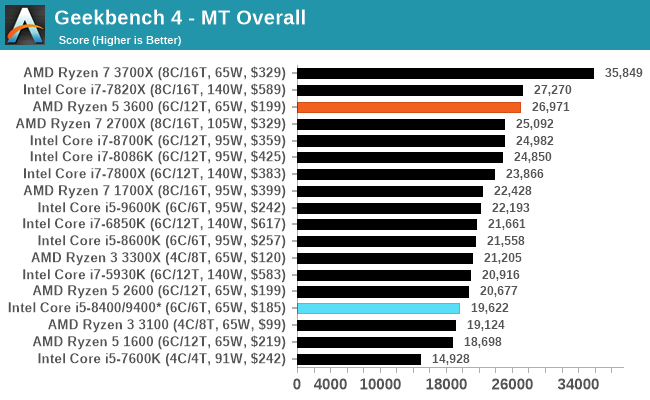
Speedometer 2: JavaScript Frameworks
Our newest web test is Speedometer 2, which is a accrued test over a series of javascript frameworks to do three simple things: built a list, enable each item in the list, and remove the list. All the frameworks implement the same visual cues, but obviously apply them from different coding angles.
Our test goes through the list of frameworks, and produces a final score indicative of ‘rpm’, one of the benchmarks internal metrics. We report this final score.

Google Octane 2.0: Core Web Compute
A popular web test for several years, but now no longer being updated, is Octane, developed by Google. Version 2.0 of the test performs the best part of two-dozen compute related tasks, such as regular expressions, cryptography, ray tracing, emulation, and Navier-Stokes physics calculations.
The test gives each sub-test a score and produces a geometric mean of the set as a final result. We run the full benchmark four times, and average the final results.
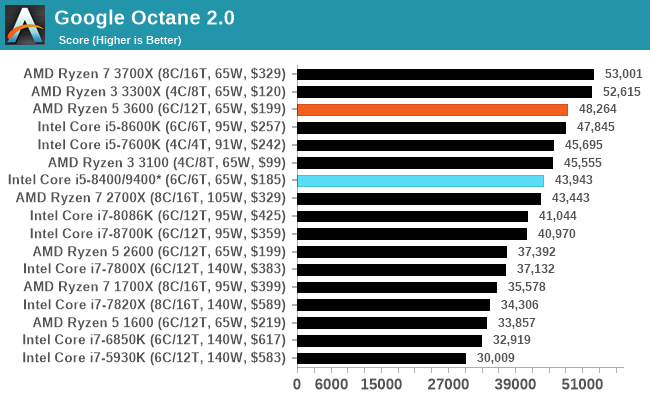
Mozilla Kraken 1.1: Core Web Compute
Even older than Octane is Kraken, this time developed by Mozilla. This is an older test that does similar computational mechanics, such as audio processing or image filtering. Kraken seems to produce a highly variable result depending on the browser version, as it is a test that is keenly optimized for.
The main benchmark runs through each of the sub-tests ten times and produces an average time to completion for each loop, given in milliseconds. We run the full benchmark four times and take an average of the time taken.
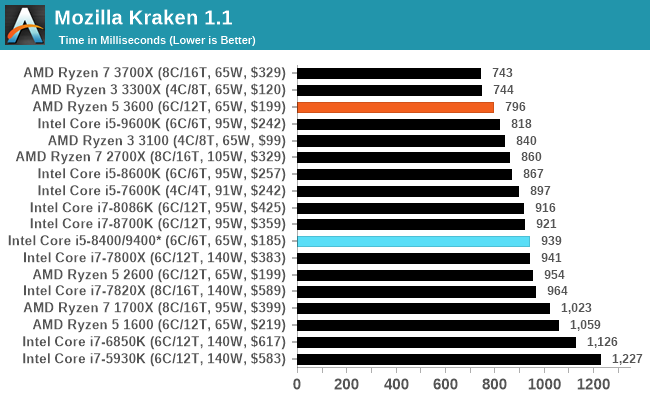
3DPM v1: Naïve Code Variant of 3DPM v2.1
The first legacy test in the suite is the first version of our 3DPM benchmark. This is the ultimate naïve version of the code, as if it was written by scientist with no knowledge of how computer hardware, compilers, or optimization works (which in fact, it was at the start). This represents a large body of scientific simulation out in the wild, where getting the answer is more important than it being fast (getting a result in 4 days is acceptable if it’s correct, rather than sending someone away for a year to learn to code and getting the result in 5 minutes).
In this version, the only real optimization was in the compiler flags (-O2, -fp:fast), compiling it in release mode, and enabling OpenMP in the main compute loops. The loops were not configured for function size, and one of the key slowdowns is false sharing in the cache. It also has long dependency chains based on the random number generation, which leads to relatively poor performance on specific compute microarchitectures.
3DPM v1 can be downloaded with our 3DPM v2 code here: 3DPMv2.1.rar (13.0 MB)
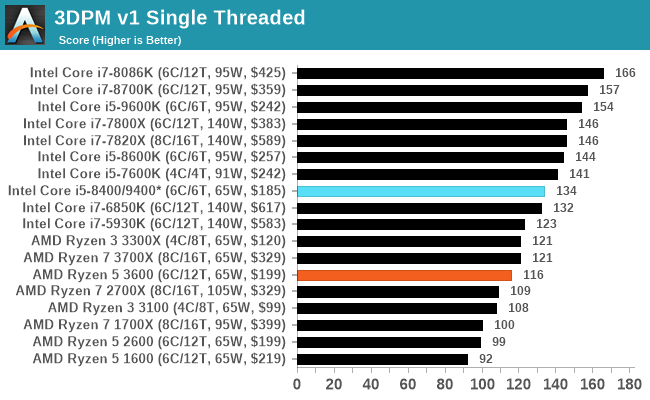
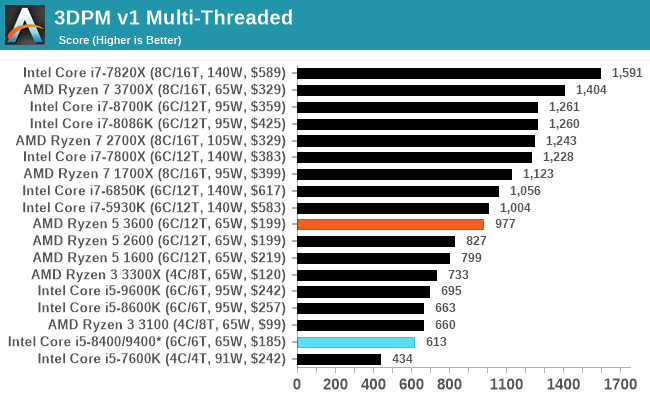
x264 HD 3.0: Older Transcode Test
This transcoding test is super old, and was used by Anand back in the day of Pentium 4 and Athlon II processors. Here a standardized 720p video is transcoded with a two-pass conversion, with the benchmark showing the frames-per-second of each pass. This benchmark is single-threaded, and between some micro-architectures we seem to actually hit an instructions-per-clock wall.

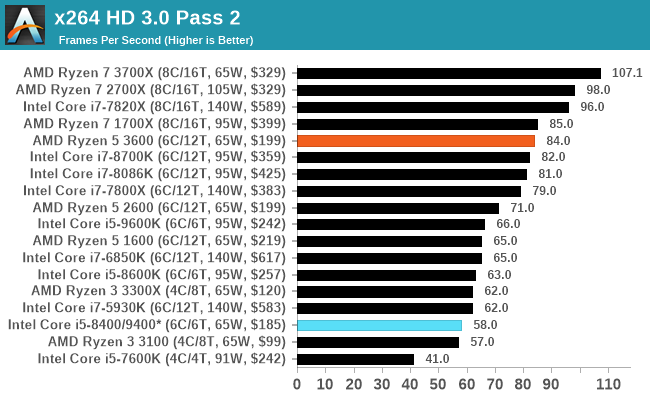










114 Comments
View All Comments
PeachNCream - Monday, May 18, 2020 - link
Anandtech spends a lot of time on gaming and on desktop PCs that are not representative of where and how people now accomplish compute tasks. They do spend a little time on mobile phones and that nets part of the market, but only at the pricey end of cellular handsets. Lower cost mobile for the masses and work-a-day PCs and laptops generally get a cursory acknowledgement once in a great while which is disappointing because there is a big chunk of the market that gets disregarded. IIRC, AT didn't even get around to reviewing the lower tiers of discrete GPUs in the past, effectively ignoring that chunk of the market until long after release and only if said lower end hardware happened to be in a system they ended up getting. They do not seem to actively seek out such components, sadly enough.whatthe123 - Monday, May 18, 2020 - link
AI/tensorflow runs so much faster even on mid tier GPUs that trying to argue CPUs are relevant is completely out of touch. No academic in their right mind is looking for a bang-for-buck CPU to train models, it would be an absurd waste of time.wolfesteinabhi - Tuesday, May 19, 2020 - link
well ..games also run on GPU ...so why bother benchmarking CPU's with them? ... same reason why anyone would want to look at other workflows .. i said tensor flow as just one of the examples(maybe not the best example) ..but more of such "work" or "development" oriented benchmarks.pashhtk27 - Thursday, May 21, 2020 - link
Or there should be proper support libraries for the integrated graphics to run tensor calculations. That would make GPU-less AI development machines a lot more cost effective. AMD and Intel are both working on this but it'll be hard to get around Nvidia's monopoly of AI computing. Free cloud compute services like colab have several problems and others are very cost prohibitive for students. And sometimes you just need to have a local system capable of loading and predicting. As a student, I think it would significantly lower the entry threshold if their cost effective laptops could run simple models and get output.We can talk about AI benchmarks then.
Gigaplex - Monday, May 18, 2020 - link
As a developer I just use whatever my company gives me. I wouldn't be shopping for consumer CPUs for work purposes.wolfesteinabhi - Tuesday, May 19, 2020 - link
not all developers are paid by their companies or make money with what they develop ... some are hobbyists and some do it as their "side" activities and with their own money at home apart from what they do at work with big guns!.mikato - Sunday, May 24, 2020 - link
As a developer, I built my own new computer at work and got to pick everything within budget.Achaios - Monday, May 18, 2020 - link
"Every so often there comes a processor that captures the market. "This used to be Sandy Bridge I5-2500K, all time best seller.
Oh, how the Mighty Chipzilla has fallen.
mikelward - Monday, May 18, 2020 - link
My current PC is a 2500K. My next one will be a 3600.Spunjji - Tuesday, May 19, 2020 - link
Sandy was an absolute knockout. Most of the development thereafter was aimed at sticking similarly powerful CPUs in sleeker packages rather than increasing desktop performance, and while I feel like Intel deserve more credit for some things than they get (e.g. the leap in mobile power/performance that can from Haswell) they really shit the bed on 10nm and responding to Ryzen.